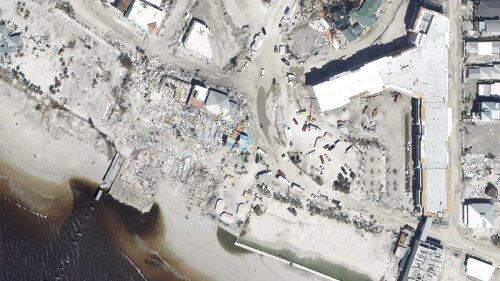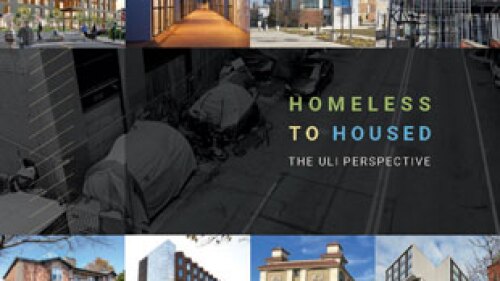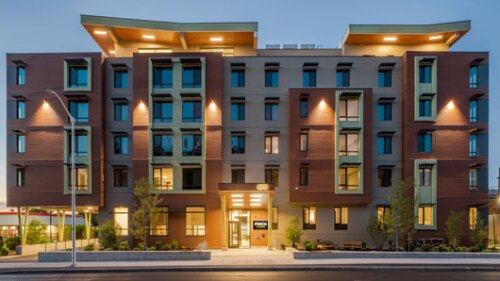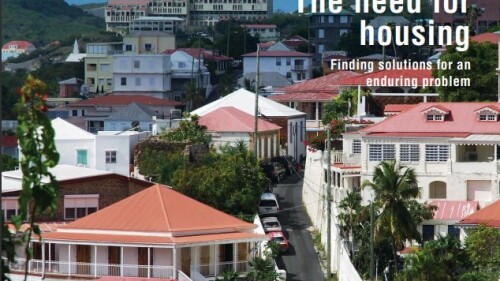
From left to right: moderator David Miller, managing director of the C40 Centre for City Climate Policy and Economy; Naama Blonder, an architect for the Kehilla Residential Programme, a nongovernmental housing agency; Carlyle Coutinho, CEO of Enwave Energy Corporation; and Mazyar Mortazavi, president and CEO of development firm TAS, speaking at the 2023 ULI Spring Meeting.
As the world struggles to deal with the threat posed by climate change, Toronto provides a template for how cities can dramatically reduce emissions at an urban scale in a way that is sustainable from a business standpoint, according to panelists at the 2023 ULI Spring Meeting in Toronto.
“The United Nations tells us that we have to act now, or it’s too late,” explained panel moderator David Miller, managing director of the C40 Centre for City Climate Policy and Economy, a global network of nearly 100 mayors of the world’s leading cities.
Toronto clearly seems to be rising to the challenge. Between 1990 and 2020, the city decreased its greenhouse gas emissions by 43 percent, setting a path to achieve net zero carbon emissions by 2040, according to the Toronto government website. Much of that progress has been made by reducing the carbon footprint of the built environment, which typically is the top or second-highest source of emissions in cities, said Miller.
“It shows what is possible when you pay attention to buildings,” he said, emphasizing that it is not enough just to design buildings for energy efficiency. The real estate sector has to work holistically with urban planners and transit, and meet the needs of the population that it is serving, in order for carbon reduction efforts to be successful.
“It’s not just how we build the buildings,” Miller said. “It’s where we build them, and how they are connected to transportation, and who we build them for.”
Toronto’s climate program works in unison with efforts to provide transit access to lower-income neighborhoods, he noted. “The transit plan came out of the city’s climate plan, because without a great transit plan, you can’t address climate change,” Miller said.
Toronto is part of a cohort of five North American cities making major progress toward net zero—San Francisco and Washington, D.C., are two others that are leading the way—but it is the only one of those cities that is also among the fastest-growing cities on the continent, noted panelist Naama Blonder. She is an architect for the Kehilla Residential Programme, a nongovernmental housing agency that is part of the UJA Federation and works to promote affordable housing in Toronto.
“Toronto is dealing with growth, like no other city that we are competing with on sustainability, and we’re doing that at the same time,” Blonder said. “As I said to my partner today, ‘Wow, housing affordability is the crisis of our generation.’ He said, ‘We have more than one crisis to choose from.’”
Another secret of Toronto’s climate progress is innovation in its energy system, explained Carlyle Coutinho, CEO of Enwave Energy Corporation. The company is a low-carbon provider of district energy, in which one or more central plants provide heating and cooling to many buildings at once through a network of pipes.
Enwave, which heats and cools many of the major buildings in downtown Toronto, started out as a city-owned corporation that provided services to hospitals and government buildings, before morphing into a private business in 1999. The company has used cold water from Lake Ontario to cool buildings, and recently completed a massive thermal storage battery under The Well, a massive multiuse complex developed by RioCan and Allied Properties. The tank, which has the capacity to hold 2 million gallons (7.6 million liters) of water, can store energy at night during off-peak times, easing the strain on Toronto’s energy grid and reducing costs, while supplying low-carbon heating and cooling to 17 million square feet (1.6 million sq m) of space inside buildings.
Coutinho praised the developers for their progressive approach. The Well’s thermal battery is “an amazing solution that was done 100 percent on a commercial basis with our partners at Allied and RioCan, two Canadian REITs [real estate investment trusts] that are very impressively forward-thinking.”
Toronto developer Mazyar Mortazavi explained how to balance business goals with environmental and social values. He is president and CEO of TAS, a development firm whose website describes it as “an unconventional impact company that uses real estate as a tool to drive profit and purpose.”
Mortazavi described a building that his firm is developing in downtown Toronto. They conducted extensive research and contemplated options that included timber, traditional concrete, and integrated fibers, before settling on low-carbon concrete combined with an enhanced building envelope and operating system.
“We look at everything from materiality to transportation to operations and assess these buildings in terms of ultimate outcomes,” he explained. “And that heavy work is a significant investment to be made in order to drive the outcomes. Everything is measured—and we don’t take this lightly—and that measurement starts from actually setting carbon budgets with our development projects.
“We ultimately ended up with a building that’s going to be built with low-carbon concrete, but with an enhanced envelope and operating systems,” said Mortazavi.





